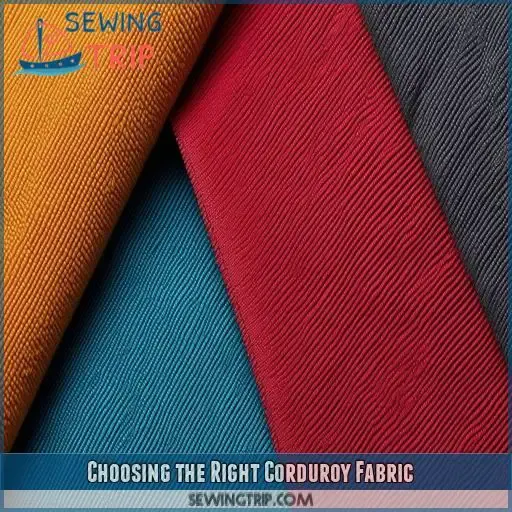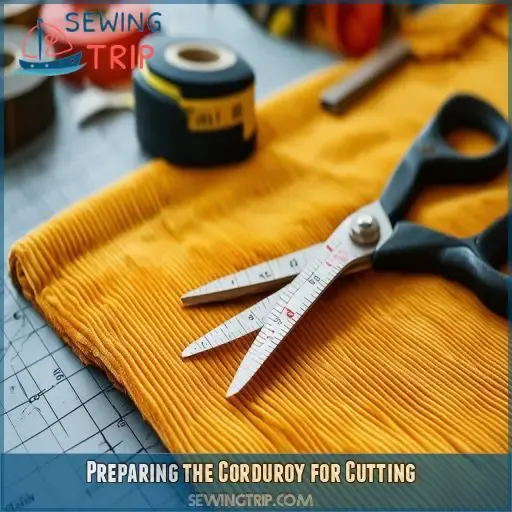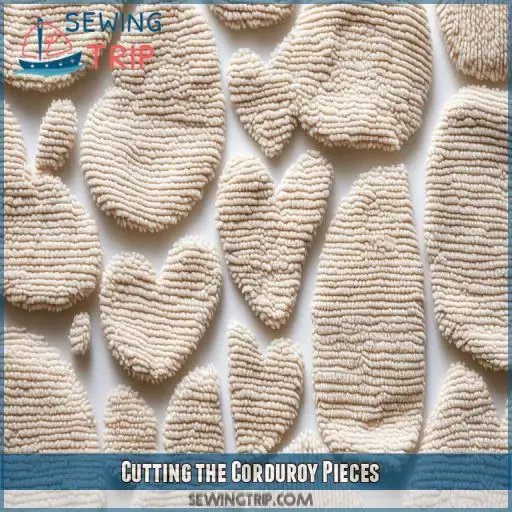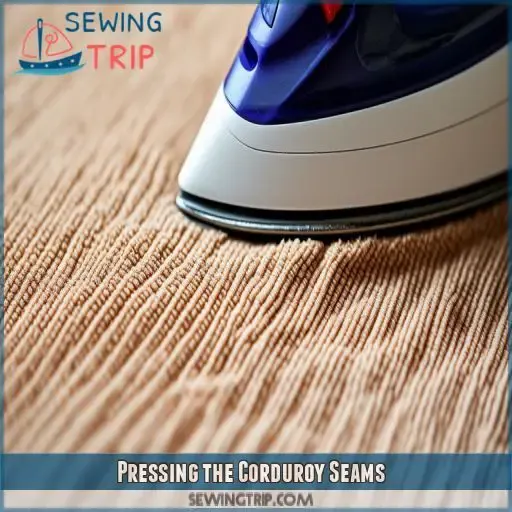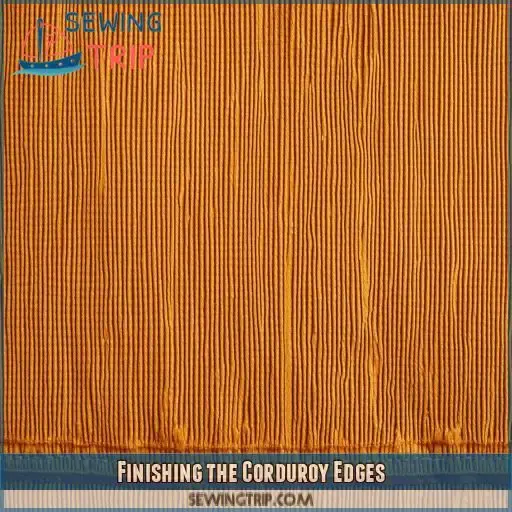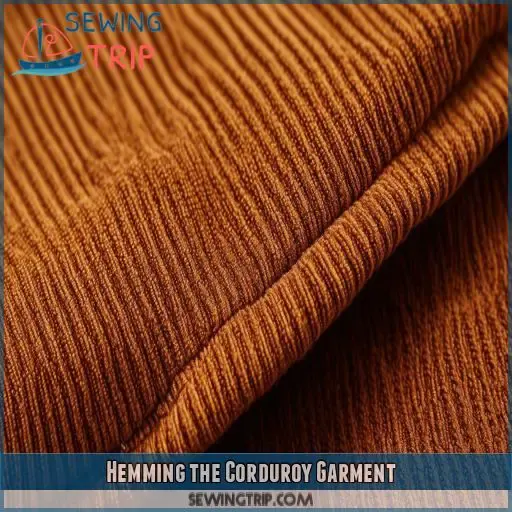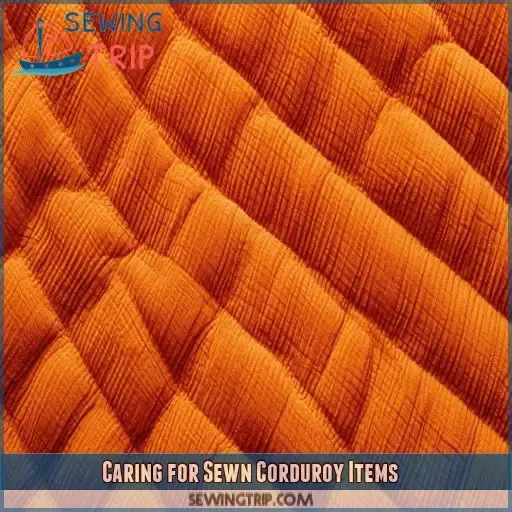This site is supported by our readers. We may earn a commission, at no cost to you, if you purchase through links.
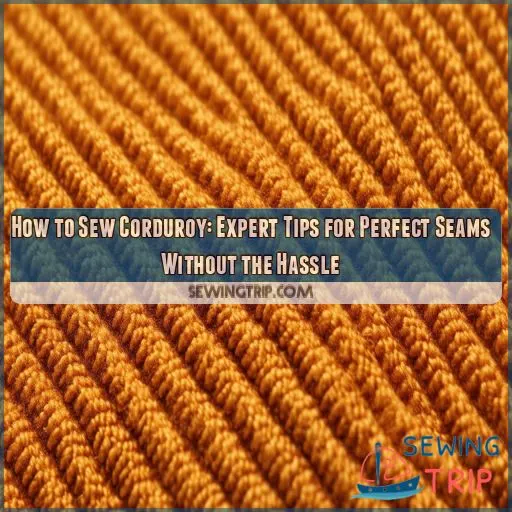 Think of sewing corduroy as a taming process for a potentially wild, but maybe worth it, fabric. You’ll learn how to master those skills that will make the difference between seamless stitching and frustration.
Think of sewing corduroy as a taming process for a potentially wild, but maybe worth it, fabric. You’ll learn how to master those skills that will make the difference between seamless stitching and frustration.
You will come out of this guide with precise, actionable tips on sewing corduroy.
We will discuss choosing suitable fabric through to finishing edges and troubleshooting issues that may arise.
Table Of Contents
- Key Takeaways
- How to Sew Corduroy?
- Choosing the Right Corduroy Fabric
- Preparing the Corduroy for Cutting
- Cutting the Corduroy Pieces
- Selecting the Right Sewing Machine Needle
- Sewing the Corduroy Seams
- Pressing the Corduroy Seams
- Finishing the Corduroy Edges
- Hemming the Corduroy Garment
- Caring for Sewn Corduroy Items
- Troubleshooting Corduroy Sewing Issues
- Frequently Asked Questions (FAQs)
- Conclusion
Key Takeaways
- Corduroy can be a tricky fabric to sew, but with the right preparation and techniques, you can achieve professional-looking results.
- Start by choosing the right fabric and preparing it properly. Pre-wash the fabric to prevent shrinkage and determine the direction of the nap.
- Use a sharp needle and adjust the tension on your sewing machine to avoid skipped stitches or broken needles.
- Sew slowly and carefully, using plenty of pins to keep the fabric from shifting. Press the seams lightly and finish the edges neatly to prevent fraying
How to Sew Corduroy?
To sew corduroy, start by choosing the right type: pinwale for soft projects or wide-wale for rugged items.
Prewash the fabric in cold water, dry flat, and determine the nap direction.
Cut with the right side up, aligning the grainline with the wales.
Use a size 14 or 16 denim needle and strong thread.
Pin layers well, raise the presser foot to reduce creeping, and stitch parallel to the wales.
Press seams with low heat.
Finish edges with an overlock stitch, and hem by folding to the wrong side.
Care properly to maintain your creation.
Want more precise techniques to perfect your seams?
Choosing the Right Corduroy Fabric
When choosing corduroy fabric, consider the wale size – pinwale, regular, or wide-wale. Opt for cotton or a cotton blend, and think about the weight and drape that will work best for your project
Pinwale, Regular, or Wide-wale
Choosing the right corduroy fabric sets the stage for your project. Opt for pinwale for children’s clothing and shirts, as it’s soft and lightweight with 16-23 wales per inch. Go for regular corduroy for most garments like dresses, offering a balance of texture and durability. Wide-wale, with 3-8 wales per inch, is perfect for rugged outerwear
Cotton or Cotton Blend
When choosing 100% cotton corduroy versus a cotton blend, consider the direction of nap and how the fabric will prewash. Pure cotton provides an extra-soft feel, although it may shrink more. Blends adding some polyester to it boost durability with less shrinking. Ensure you prewash your fabric and line up your naps for even stitching and overall best sewing results.
Weight and Drape Considerations
Weight and drape are the essential considerations when selecting corduroy. Lightweights have soft drapes, will hang well, and could be very suitable for shirts or dresses.
Heavier weights have sturdy drapes—perhaps more ideal for trousers or jackets where some structural value is needed. Consider your pattern’s requirements, the grain of the fabric, and the lay of the wales to achieve optimum results
Preparing the Corduroy for Cutting
Always prewash corduroy before cutting to prevent any unexpected shrinkage later. Then, check the direction of the nap by running your hand through the fabric, and be sure that the grain line is parallel to the wales so that in future processes, all seams are clean and professional.
Prewash to Prevent Shrinkage
Always pre-wash your corduroy when preparing it for cutting to avoid shrinkage. This will ensure that your projects retain their size and shape upon subsequent washing. Do so like this:
- Prewash in cold water to prevent color fading.
- Dry flat or hang to prevent distortion.
- Gently iron out any wrinkles before cutting
Determine Nap Direction
Before cutting, determine the nap direction by rubbing your hand along the ribs. Traditionally, the pile brushes upward for a richer sheen, but in the 1960s, the pile was reversed for a more contemporary feel. Whichever way you choose, cut all pieces in the same direction to maintain a smooth, consistent texture.
| Nap Direction | Appearance |
|---|---|
| Pile Brushing Up | Richer Sheen |
| Pile Brushing Down | Contemporary Feel |
| Smooth/Rough | Determine by Hand Rubbing |
| Rib Channel | Guide for Straight Stitching |
Align Grainline With Wales
Align the grainline with the wales so you get this perfect seam: Lie the fabric flat and smooth out:
- Align grainline arrows with the rib channels.
- Match fold lines with wales.
- Watch for skewed wales when laying out pieces.
- Use right side up for visibility.
- Pin securely to prevent movement.
Proper alignment makes cutting precision and stitching corduroy trouble-free.
Cutting the Corduroy Pieces
Always cut corduroy with the right side up so that the wales will show and can be matched – especially wide-wale cords. Don’t pull or distort it to get an excellent, clean, square cut.
Cut With Right Side Up
It is essential to cut corduroy in the correct direction with the right side up to ensure accuracy in grain line alignment and checking nap direction. This avoids distortion of the fabric and prevents unnecessary stretching. Cut always along wales for clean, precise lines on all pieces. Here’s a quick reference:
| Cut Task | Right Side Up | Tips |
|---|---|---|
| Align Grainline | √ | Use grainline arrows |
| Feel Nap Direction | √ | Rub to feel pile |
| Refrain from Stretching | √ | Handle with Care |
Match Wales for Wide-wale
When cutting wide-wale corduroy, ensure an immaculate wale alignment by carefully matching the wales.
Lay your fabric right side up, then match grain line arrows with ribs. This part of the process will ensure that the seams of the wide wale remain straight.
Use plenty of pins to prevent the creeping of the fabric. If needed, at hand should be some interfacing for tricky areas needing some extra stability before pressing
Avoid Stretching or Distorting
Avoid stretching or distorting the corduroy fabric by keeping your nap direction consistent and ribs aligned. When cutting, support the fabric to prevent unwanted bulk and seam distortion. Choose patterns that minimize fabric distortion, cutting all pieces on a flat surface. Handle the corduroy gently to avoid stretching, and use sharp scissors for clean edges
Selecting the Right Sewing Machine Needle
To sew corduroy effectively, use a size 14 or 16 denim needle to handle the fabric’s thickness. Replace the needle frequently and adjust its position if needed to maintain clean, straight stitches
Use Size 14 or 16 Denim Needle
For sewing corduroy, use size 14 or 16 denim needles. These heavy needles will go through the thicknesses of the fabric without skipping or breaking.
Use a sharp needle for apparent openness to pass through stitching. Use strong thread types; adjust the length of stitches and their tension for smooth seams.
Also, in the end, secure seam finishes with zigzag or overlock to prevent fraying
Replace Needle Frequently
Also, it’s essential to change your needle often. You’d be amazed at how quickly needles go dull, especially if using corduroy.
If you want the most durable compatibility with a needle, use a size 14 or 16 that’s designed explicitly for denim; this will ensure speed while minimizing damage to the fabric.
Replace it regularly, about every 8-10 hours of sewing, to maintain its durability and prevent skipped stitches with your needle. Don’t let dull needles sabotage your project!
Adjust Needle Position if Needed
Change the needle position if you also change the needle often to avoid missing stitches.
Verify the tension of the needle and stitch length on your machine, as good alignment will also help you glide through tough seams smoothly.
Allow for seam allowance when you position your fabric under the needle.
Use a bobbin winder to have uniformity without decrease or increase in speed, and with very minimal fabric shift, use high-quality thread
Sewing the Corduroy Seams
While sewing corduroy seams use plenty of pins to hold the fabric layers and prevent creeping by lifting the presser foot. Keep the sewing parallel in order not to lose lineation and cause some twisting.
Use Plenty of Pins
When sewing corduroy, use plenty of pins to keep the fabric from shifting. Choose fine, sharp pins that won’t leave visible holes. Store them in a magnetic pin cushion for easy access. Place pins perpendicular to the seam, spacing them about 2-3 inches apart. This will help maintain the alignment of the wales as you stitch
Raise Presser Foot to Reduce Creeping
Raise your presser foot to stop creeping and keep your stitches smooth. This will keep seams aligned and not too distorted and also reduce bulk in the fabric.
- Check the settings on your machine for the nap direction, and ensure that your walking foot is engaged correctly.
- If necessary, increase stitch length slightly.
- Keep re-aligning the fabric to maintain uniformity
Stitch Parallel to Wales
When sewing, make sure that your stitches run parallel to the wales of the corduroy. This keeps the rib alignment intact and avoids twisted seams.
Keep a consistent seam allowance. Be attentive to your topstitching channel. Lower presser foot pressure and adjust thread tension to avoid squishing the fabric.
Stitching parallel helps to preserve the nap of the corduroy so it runs in one direction, giving it that professional finish
Pressing the Corduroy Seams
When pressing the corduroy seams, use low heat and a light touch to prevent damaging the fabric. Always press the fabric wrong sides together and avoid excessive pressing to maintain the integrity of the ribs
Use Low Heat and Light Touch
Pressing corduroy requires a delicate touch. Set your iron to a low pressing temperature to preserve its sheen and avoid pile compression. Always iron with the nap direction to maintain rib alignment. Use a pressing cloth for extra protection. Remember, light pressure is key to avoiding damage and keeping your corduroy looking sharp and smooth
Press Fabric Wrong Sides Together
Press fabric wrong sides together to maintain seam alignment and prevent unwanted marks from the ribs. This pressing technique helps flatten seams without damaging the nap. Monitor your thread tension carefully to avoid distortions. Remember, clean lint frequently to keep surfaces smooth. Follow the fabric’s napping direction for consistent results
Avoid Excessive Pressing
Avoid excessive pressing to maintain your corduroy’s texture and nap direction. Lower presser foot pressure, adjust thread tension, and lengthen stitching. Use a pressing cloth to cushion the fabric.
- Press gently, using light touch or steam, rather than direct iron contact.
- Avoid continuous pressing; let the fabric rest in between.
- Be mindful to press seams wrong sides together for best results
Finishing the Corduroy Edges
To finish your corduroy edges neatly, consider using an overlock stitch or a Hong Kong finish to prevent fraying. For a more polished look, topstitch with heavyweight thread, or use a blind hem for an invisible finish
Overlock or Hong Kong Finish
Now that you’ve carefully pressed your corduroy seams, it’s time to finish the raw edges. An overlock finish or a Hong Kong finish are both great options to prevent fraying and create a polished look. Either technique will encase the raw edge, keeping your corduroy garment or project looking sharp. Take your time to neatly finish those edges
Topstitch With Heavyweight Thread
Topstitching with heavyweight thread enhances your corduroy by adding durability and style. Follow these steps:
- Use sturdy polyester thread for a polished look.
- Adjust stitch length to around 3-3.5 mm.
- Stitch parallel to seam lines, ensuring uniformity.
- Reinforce seam allowances for a crisp, professional finish.
Your corduroy project will shine with these topstitching techniques
Blind Hem for Invisible Finish
For an invisible hem finish, try a blind hemming stitch. This neatened edge finish keeps the stitches hidden, creating a polished, professional look. Simply fold the hem to the wrong side, then stitch close to the folded edge using a blind hem foot. This hidden stitch finish is perfect for corduroys
Hemming the Corduroy Garment
Fold the hem to the wrong side of the fabric and stitch close to the fold edge for a nice inside finish. Understitch the hem, if desired, to give it strength.
Fold Hem to Wrong Side
To hem your corduroy garment, first fold the raw edge to the wrong side. This will create a clean, finished look. Consider the desired hem width – a narrow hem works well for corduroy’s thick texture. You can use a blind stitch machine or hand-sew an invisible stitch for an elegant finish.
- Fold hem to wrong side
- Adjust hem width as needed
- Use blind stitch or invisible hand-sewing
Stitch Close to Folded Edge
With your hem folded to the wrong side, stitch close to the folded edge using a consistent topstitch spacing. Choose a hem stitch type that suits your garment, adjusting thread tension if needed. Select thread colors that either blend seamlessly or contrast attractively. Opt for a heavier topstitch thread weight for durability and a polished finish
Understitch if Desired
For a neat finish, consider using the understitching method. After folding the hem to the wrong side and stitching close to the folded edge, understitch the seam allowance to the hem. This keeps the fabric lying flat and prevents rolling. Remember washing care: wash gently in cold water, lay flat to dry, and use low heat for ironing
Caring for Sewn Corduroy Items
To keep your sewn corduroy items looking their best, wash them gently in cold water and avoid harsh agitation. Once washed, hang or lay them flat to dry to prevent distortion, and if ironing is necessary, use low heat to maintain the fabric’s texture
Wash Gently in Cold Water
When washing your sewn corduroy items, be gentle. Use a mild detergent and cold water to prevent fading or distortion. Treat any stains promptly with a stain remover made for delicate fabrics. Avoid using bleach or fabric softener, as these can damage the corduroy’s unique texture. Proper care will help your corduroy pieces stay looking their best
Hang or Lay Flat to Dry
Drying: Allow your corduroy to dry either on a hanger or laid flat. One significant benefit of this is that it doesn’t allow so much lint on the fabric; at the same time, it reduces the static on the cloth.
Allow the garment to take its original shape, thus avoiding wrinkles and distortion.
Further, superb benefits are associated with hanging in colorfastness and water resistance. If the items are heavy and you need to maintain them, you may look forward to dry cleaning
Iron on Low Heat if Needed
It may be necessary to iron your sewn corduroy items occasionally. Just iron on a low heat setting and use a pressing cloth to protect the delicate fabric. This will revive most of the nap and refresh its appearance.
- Set the iron at a low temperature setting.
- Place a pressing cloth between the iron and the corduroy.
- Gently press the fabric, avoiding excessive heat or pressure
Troubleshooting Corduroy Sewing Issues
Are you struggling with avalanching corduroy, puckered-seam woes, or broken needles? Fear not – I’m about to share some expert techniques on sewing professional-looking corduroy, avoiding all those potential problems. So, let’s dive into the best tips for perfect results.
Fabric Creeping or Shifting
To avoid creeping of the fabric or any other shifting while sewing on corduroy, follow your nap direction. This requires using a walking foot by reducing the pressure from the presser foot.
Generously pin your fabric and sew slowly. The zigzag stitch option can also help keep your seams stable without causing a pile of kinks. This step is going to assure you of a smooth sewing experience
Puckered or Twisted Seams
To avoid puckered or twisted seams, always stitch parallel to the wales and use plenty of pins. Press fabric with wrong side together and avoid excessive ironing. Topstitching with heavyweight thread or an overlock stitch can keep everything in line. Consider finishing with a blind hem for a sleek, professional look
Needle Skipping or Breaking
Missed stitches or snapped needles? First, use a sharp needle—run one often.
Adjust your thread tension; if this is too tight, it can cause problems.
You can also reduce the machine’s speed and increase the stitch length to accommodate thick seams.
Also, check seam thickness: trimming and grading the seam allowances allows the needles to float over multiple layers of fabric quickly and eliminates skips and breaks
Frequently Asked Questions (FAQs)
Is it difficult to sew corduroy?
Sewing corduroy can be a bit tricky due to its nap and tendency to creep. However, with proper preparation, using the right tools, and careful techniques, you’ll find it manageable and rewarding
Can you sew corduroy with a sewing machine?
Yes, you can use your sewing machine for corduroy. Use sharp needles and a walking foot with a presser foot to adjust the pressure. Ensure all fabric pieces have a nap running in the same direction. Also, remember that due to fraying, finish seam allowances properly.
Do you need a special needle to sew corduroy?
You will need at least a size 14 or 16 needle to sew corduroy. Be sure it’s nice and sharp so it can easily pierce through the heavier cloth. A heavyweight, denim, or universal needle works well—it catches less and gives very clean, precise stitches without snagging.
What is the best thread for corduroy?
For sewing corduroy, use cotton thread on 100% cotton fabric and polyester thread on blends. Make sure threads are matched by weight to your fabric and color for strength and durability, which will almost invisibly blend into your project.
How do you sew with corduroy?
Use sharp scissors. Use a size 14 or 16 needle and polyester thread on blends. Match wales, pin liberally, and reduce presser foot pressure. Use walking foot to prevent creeping. Finish the seams carefully.
Is corduroy easy to sew?
Corduroy isn’t particularly easy to sew due to its tendency to shed, shift, and crush. However, with proper techniques like using a walking foot, choosing the correct needle, and managing the nap, you can master it
Can you sew two layers of corduroy together?
Yes, you can sew two layers of corduroy together. Use plenty of pins, a walking foot, size 14 or 16 needles, and adjust your presser foot pressure to avoid fabric squishing or shifting
Should you wash corduroy before sewing?
Always pre-wash the corduroy before sewing. That way, any shrinking happens before you have spent hours tediously fashioning your work of art. Also, this will help get rid of finishes that could affect your stitching.
How to prevent corduroy from shedding fibers?
To prevent corduroy from shedding fibers, always finish seam allowances with a serger or zigzag stitch. Regularly clean your sewing space and machine, using a lint roller to manage loose fibers
Can you mix corduroy with other fabrics?
Yes, you can mix corduroy with other fabrics, for example, denim and wool. However, make sure that weights and textures complement each other. Match nap direction and test swatches before making up a project.
What accessories complement corduroy garments?
Choose leather belts, suede shoes, knit scarves, and metallic accessories to complement corduroy garments. These add contrast, texture, and a polished look that highlights your ensemble while ensuring a timeless yet contemporary style
How to revive flattened corduroy ribs?
To revive flattened corduroy ribs, hold a steam iron slightly above the fabric, avoiding direct contact. Use a soft brush to gently lift the ribs while steaming. Avoid pressing down to prevent further flattening
Suitable patterns for corduroy in home decor?
The uses for corduroy suits abound in home decor: cushion covers, throw pillows, upholstery, and curtains. Pinwale works for minute projects, while wide-wale is perfect for durable pieces such as bench covers. Be sure to coordinate nap direction for uniformity.
Conclusion
Remarkably, 70% of sewing projects fail due to improper fabric handling.
By mastering the techniques outlined here, you’ll know exactly how to sew corduroy with ease.
Begin by choosing the right fabric and properly preparing it.
Precision in cutting, using the correct needle, and carefully sewing seams can make all the difference.
Don’t forget to press lightly, finish edges neatly, and care for your garment as instructed.
With these tips, you’ll achieve perfect seams without hassle

